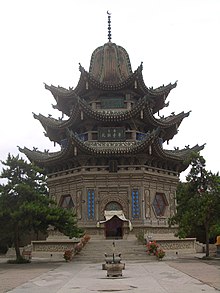Our website is made possible by displaying online advertisements to our visitors.
Please consider supporting us by disabling your ad blocker.
Ma Laichi
| Part of a series on Islam in China |
|---|
 |
|
|
Ma Laichi (1681? – 1766?;[1] simplified Chinese: 马来迟; traditional Chinese: 馬來遲; pinyin: Mǎ Láichí; Wade–Giles: Ma Lai-chih), also known as Abu 'l-Futūh Ma Laichi, was a Chinese Sufi master who brought the Khufiyya movement to China and created the Huasi menhuan (Sufi order) - the earliest and most important Naqshbandi (نقشبندية,納克什班迪) order in Chinese Muslim history.[2][3]

- ^ As it is often the case with the 17th and 18th-century Hui Sufi figures, the chronology of Ma Laichi's life is not set firmly. Gladney (1996) (p. 47) gives no birth year, and 1766 as the death year; Weismann (2007) (p. 83), gives no birth year, and 1753 as the death year. Lipman (1998) does not give exact years for birth and death, and emphasizes differences between different historians' chronologies (p. 67); however, adding up lengths of time intervals in his biographical account implies that Ma would be close to 48 in 1728. The Great Chinese Encyclopedia (中国大百科全书, vol. 14 宗教 (Religion), p. 255) gives 1681-1766.
- ^ Gladney (1996), pp. 47-48
- ^ Lipman (1998), p. 65-67
Previous Page Next Page


